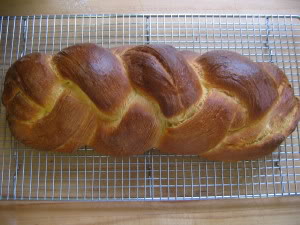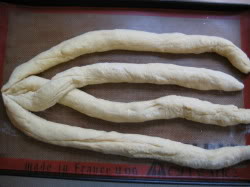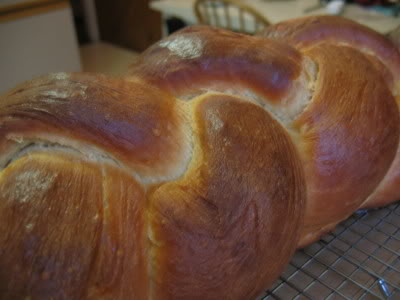What’s that you say—today is Tuesday, not Friday? Well I know that, silly. This is another one of those memory pieces, in which I wax rhapsodic about a food I grew up on and then attempt to recreate it. Today’s episode: Challah.

As I’ve mentioned before, my mom suffered from a disabling depression through much of my childhood. Many days she was still in bed when we got home from school. I’d creep into her darkened room, clutching a starred paper or a drawing or a permission slip, and stand by the side of the bed to rouse her. Even when her voice was sluggish and monotone, she always managed to express how proud she was of all of us, and especially me, the only daughter. Often I’d climb in beside her for a while, chattering in the darkness while she dozed. I suppose I knew most kids’ moms weren’t like this, but it was normal to me. In a way I enjoyed lying there with her. The darkness was soothing, and intimate, and I felt loved.
Friday was the one day of the week where I could be fairly certain that Mommy wouldn’t be in bed at 3PM. That night was Shabbat, and there would be cooking to do, roast chicken or brisket, kugel or roasted potatoes, and always a bag of frozen vegetables (which would be steamed at the last minute). It was the one night of the week we had dessert, too, sometimes store-bought Rich’s brand frozen chocolate éclairs or Stella D’Oro Swiss Fudge Cookies (my family kept kosher, so it had to be a pareve sweet, with no dairy ingredients) but often a marble bundt cake or for a special treat, Fudgy Chocolate Pudding Cake, served warm with non-dairy whipped topping running down it in melting drizzles. And it wouldn’t be Shabbat without challah.
By the time we got home, the eggy dough would already be made and well into its first rise. Usually it was a double-batch, enough to make one large braided loaf and a dozen smaller rolls—a mixture of mini-challahs and my favorite, the small knots we called “pupie rolls” (rhymes with “cookie”—from the Yiddish word pupik, for belly-button). If Mommy was feeling ok that day, she’d wait for us to come home before rolling it out. The dining table was the first thing you’d see upon entering the apartment, and since the galley kitchen could only accommodate solo cooks, the table did double-duty as a prep space. When we opened the door we’d know right away if Mommy needed Baker’s Helpers for the afternoon—either her vinyl baking mat would be spread out on the table, a big covered bowl of yellow dough and the flour canister waiting patiently alongside, or prepared loaves would already be rising on rimmed cookie sheets. On Fridays when help was called for, we’d each get our own little ball of dough to work on, rolling it into thin snakes and trying our best to braid it, or make a little pupik. Picture one depressed woman in her late thirties, and four children between 2 and 10, sleeves pulled up, hands messy. I remember a lot of giggling, and flour everywhere. We’d fight over who got to sprinkle the sesame seeds on top—I always felt I could do it better, neater, than my brothers. And the smell while the loaves were baking—a deep fragrance, not like plain bread, richer and more mysterious. It was always so hard to wait until later for a taste.
Just before dinner, Mommy and I would light the Shabbat candles and circle our hands three times over them, covering our eyes while reciting the blessing. She’d always stand there for a few moments afterwards, adding her own special request for God to take care of her family. Then Daddy would say the brachot over the wine and the challah, and pass each around the table so we could all have a taste. My parents’ Friday nights must be very different now, with just the two of them. Of the four kids, only my oldest brother still observes the way we did growing up. When we have children, perhaps S and I will create our own, modified version.
After Pumpkin Bread Pudding emerged victorious from my Sugar High Friday poll, I asked my mom for her challah recipe—challah is one of the main ingredients in the dish, and I’ve never baked it on my own before. The recipe she sent me is from Canadian Living magazine, but she assures me it’s virtually identical to the one she used to use—once her arthritis got too bad and we had all moved out, she stopped baking just for her and my dad. They use purchased challah now, except for on special occasions. Baking it on a rainy Tuesday was strange—it felt almost inappropriate, and I was nervous, as if making a small mistake would ruin everything. Once I started I realized I’d never actually seen my mom making the dough itself—that always happened while we were at school—so I had to wing it, using my own experience with baking “regular” bread. In the end it looks beautiful, doesn’t it? I won’t know how it tastes until much later, when I cut it up to make the bread pudding. Just like when I was a kid, I can hardly wait.

Challah
(with how-to video on Canadian Living’s site)
Ingredients:
2 t. granulated sugar [see note in instructions]
½ cup warm water
1 pkg, or 1 T., active dry yeast [I use SAF instant yeast—about ¾ T.]
3½ cups all-purpose flour (approx)
1 t. salt
½ cup honey
¼ cup vegetable oil
2 large eggs, lightly beaten
2 large egg yolks
Topping:
1 large egg yolk, lightly beaten with 1 t. water
1 T. sesame seeds
1. In large bowl, dissolve sugar in warm water. Sprinkle in yeast; let stand until frothy, about 10 minutes. Using wooden spoon, stir in 3 cups of the flour and salt. Add honey, oil, eggs and egg yolks; stir until dough forms.
[If using SAF, like I did, there’s no need to proof the yeast with sugar and water. Just put the plain water in the bowl, and add yeast with the flour and salt. Skip the granulated sugar entirely.]
2. Turn out dough onto lightly floured surface; knead until smooth and elastic, about 10 minutes, adding enough of the remaining flour as necessary to prevent sticking. Place in greased bowl, turning to grease all over.

Cover with plastic wrap; let rise in warm draft-free place until doubled in bulk and indentation remains when dough is poked with 2 fingers, about 1 hour.

3. To make braid: Divide dough into quarters; roll each into 18-inch long ropes. Place side by side on greased rimmed baking sheet; pinch together at 1 end. Starting at pinched end, move second rope from left over rope on its right. Move far right rope over 2 ropes on left. Move far left rope over 2 ropes on right. Repeat until braid is complete; tuck ends under braid.

4. Cover loaf with plastic wrap; let rise in warm draft-free place until doubled in bulk, about 1 hour.

5. Topping: Stir egg yolk with water; brush over loaf. Sprinkle with sesame seeds. [Because I’m using this in another recipe, I skipped the sesame seeds. But seeds are an integral part of the challah experience, so I encourage you to use them!]
Bake in center of 350°F oven until golden brown and loaf sounds hollow when tapped on bottom, 35 to 45 minutes [35 was plenty in my oven]. Let cool on rack.
Happy Hanukkah, everyone!
